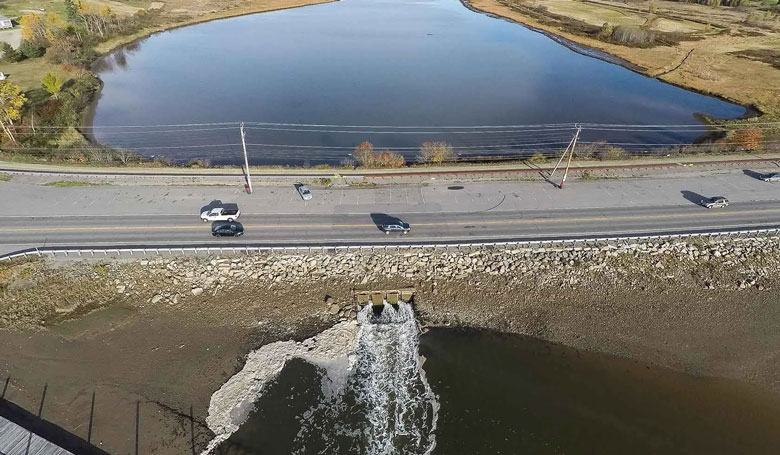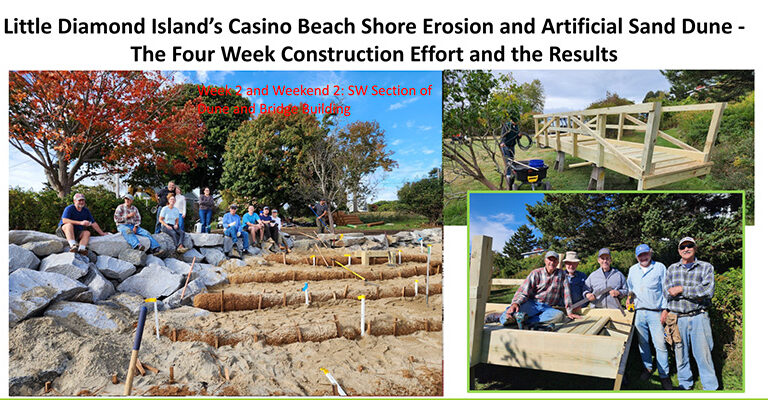One recent late August evening, a few tourists gathered on the deck of Helen’s Restaurant overlooking the Machias River. The summer holdouts tugged sweaters closer and steadied their glasses while trapping napkins that threatened to fly away. This time of year, the river’s breezes grow colder and lustier, as if crying out to Machias Bay and the open sea just around the bend.
Come winter, the sea and the bay will answer back with a roar, if last winter’s violent storms are any warning.
“We were like a little island,” said Julie Barker, co-owner of Helen’s Restaurant, a tidy, white-clad building perched at the edge of the river with the Machias dike in its dooryard. “We were surrounded by water until the tide receded.”
Over the past six years, catastrophic storms with surging tides dumped floodwaters in Machias far surpassing the base flood elevation, classifying the events as 100-year floods. Last winter alone, three floods overwhelmed the dike and much of the surrounding downtown, including forcing the town hall to move, a change that has become permanent.
Meanwhile, the erosion on the century-old dike—a significant cause of that flooding—remains inadequately mended. After 15 years of studies, hearings, and back-and-forth plans, the public still awaits a Maine Department of Transportation decision about how it will fix the problem—a dike that keeps crumbling and flood waters that keep coming.
Residents and other stakeholders are left in the dark, speculating on when a replacement dike will be built.
The DOT’s decision, or even the status of the environmental impact assessment needed to arrive at a decision, has been delayed yet again—now the public hearing is not expected until fall.
Originally scheduled for the spring, the public hearing was pushed back, then pushed back again this summer. Beyond references to additional talks among stakeholders, and the public hearing possibly sometime in October, town and state officials remain tight-lipped.
“This is a complex project involving many different issues and stakeholders. I don’t expect to have anything new to add before the public hearing,” said Paul Merrill, DOT’s director of communications, in a written response to questions.
Four years ago, DOT published a “Purpose and Need for Action” report, detailing studies dating to 2016. Since then, flood waters have exceeded the base flood elevation eight times, each one chomping at the dike’s foundation.
Last November, after portions of the foundation washed away, DOT had to temporarily close the dike, which carries Route 1 over the Machias River at the nexus of Middle River and Machias Bay. Residents were forced to take lengthy detours until a temporary span was erected that month.
A permanent solution is no closer and many experts say the DOT’s preferred, “in-kind” replacement plan won’t prevent or even mitigate flooding.
Merrill, in a June email, wrote that DOT’s “draft EA (environmental assessment) analyzes alternatives and identifies the fully gated replacement culverts as the (DOT’s) preferred alternative.”
Merrill added that the Federal Highway Administration would be at a future public meeting to discuss the environmental assessment soon after it is published. The FHWA will review public comments then make its final findings. The agency must give the green light for any plan to go forward because the dike spans Route 1, a federal highway.
But DOT’s draft assessment still hasn’t been made available to the public. Coupled with the public hearing repeatedly being pushed back, Downeast residents and other stakeholders are left in the dark, speculating on when a replacement dike will be built.
For the last two years, representatives from various private, non-profit groups and government agencies have met as members of the Machias Downtown Resiliency Group to develop a flood mitigation plan. They have worked with DOT and voiced concerns about the agency’s preferred dike replacement plan.
Downtown Machias isn’t the only focus of concerns about the prospect of another violent storm season. The Downeast Salmon Federation and other conservation groups, including Maine Coast Heritage Trust, are in a race to restore salt marshes along the coast, including the Schoppee salt marsh just around the corner from the dike.
The marsh also gets ravaged by violent storms. Tidal surges routinely overtop the adjacent Downeast Sunrise Trail that straddles the marsh and the river. The constant deluge compromises the delicate balance of a crucial natural resource.
Last winter was literally the breaking point.
The trail was largely washed away along the river. It was closed, then reopened once repairs were completed by DOT earlier this summer.
Bigger rip rap was put in along the dike and the trail, new culverts installed, and the rebuilt trail was topped with a thick bed of crushed stone. A wide, neatly manicured berm was also added.
Flood mitigation experts say it all amounts to window dressing, with the Downeast Salmon Federation’s Charlie Foster arguing culverts won’t hold back the force of the sea.
The Downeast Salmon Federation designed a plan that includes installing a bridge over the most vulnerable parts of the trail. Foster said they have several grant applications pending, totaling roughly $30 million, to pay for the project and the group is confident it will receive the grants because the state and federal governments have made salt marsh restoration a priority.
Foster and others say the best solution for the Schoppee Marsh, as well as for Machias residents and businesses, would be to replace the dike with an elevated section and add a series of gated culverts to allow a gradual release of waters into Middle River.
Foster acknowledged it would be expensive, and cost has been a major consideration for DOT, but believes the project could easily be funded with the grant money available through the infrastructure law and from other sources. But he said they need to act fast because that money will dry up soon.
“It’s not going to be a permanent thing,” said Foster. “A lot of that extra money is based on the bipartisan infrastructure law … and you’re only looking at a couple more years of that kind of surge of money.”
Costs also are a concern for residents who have to brace for the worst.
Julie and David Barker, who own Helen’s Restaurant, spent about $5,000 this year shoring up the banks below the restaurant with more prodigious rip rap. They also pay an extra $2,000 for flood insurance.





